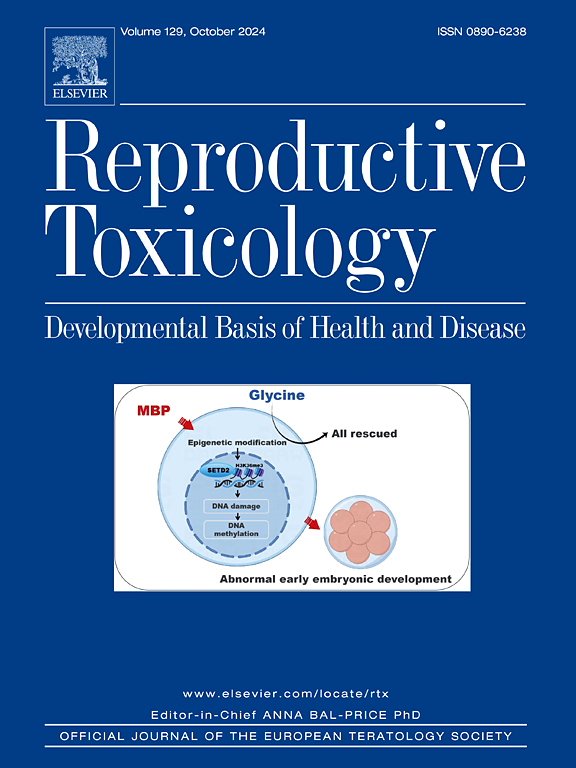The biological effects of bisphenol AF in reproduction and development: What do we know so far?
IF 3.3
4区 医学
Q2 REPRODUCTIVE BIOLOGY
引用次数: 0
Abstract
Due to the established endocrine-disrupting effects of Bisphenol A (BPA), alternative bisphenols entered the market. Bisphenol AF (BPAF) is now commonly used in the industrial manufacturing of polycarbonate plastics and epoxy resins. However, BPAF’s effects on reproduction and development have not been thoroughly reviewed. We investigated the relationship between BPAF exposure and reproduction and early development. We performed a literature review of studies on BPAF and reproductive physiology. Using keywords, we searched PubMed, Medline, Cochrane Library Database, Embase, and ClinicalTrials.gov for English language literature available until December 2024; we additionally identified and included studies from bibliographies. We included 125 articles, spanning in vitro and in vivo model organism and human studies. BPAF is a selective estrogen receptor modulator and an androgen receptor antagonist and is more potent than BPA. It is detected in urine, blood products, saliva, amniotic fluid, and breast milk. In vitro and in vivo studies demonstrate a spectrum of BPAF-induced endocrine and reproductive changes in both sexes. There is strong evidence of alterations in the hypothalamic-pituitary-gonadal axis and of altered steroidogenesis pathways. Multiple studies using zebrafish, Xenopus, chickens, and rodents, show BPAF’s effects on embryogenesis, morphology, and sexual differentiation. Decreased serum testosterone and impaired spermatogenesis and oocyte viability have been demonstrated. The current literature shows clear disruptive effects of BPAF on reproductive health and embryonic development. Though further investigation is warranted, there is ample converging evidence to support limiting the use of BPAF and other similar bisphenols.
双酚AF在生殖和发育中的生物学效应:到目前为止我们知道什么?
由于双酚A (BPA)具有内分泌干扰作用,替代双酚进入市场。双酚AF (BPAF)现在广泛用于工业制造聚碳酸酯塑料和环氧树脂。然而,BPAF对生殖和发育的影响尚未得到全面的研究。我们调查了bpa暴露与生殖和早期发育之间的关系。我们对BPAF与生殖生理学的研究进行了文献综述。使用关键词,我们检索了PubMed、Medline、Cochrane图书馆数据库、Embase和ClinicalTrials.gov,以获取截止2024年12月的英文文献;我们还从参考书目中确定并纳入了研究。我们纳入了125篇文章,涵盖了体外和体内模型生物和人体研究。BPAF是一种选择性雌激素受体调节剂和雄激素受体拮抗剂,比BPA更有效。它可以在尿液、血液制品、唾液、羊水和母乳中检测到。体外和体内研究表明,在两性中,bpaf会引起一系列的内分泌和生殖变化。有强有力的证据表明,下丘脑-垂体-性腺轴的改变和类固醇生成途径的改变。对斑马鱼、爪蟾、鸡和啮齿动物的多项研究表明,BPAF对胚胎发生、形态和性别分化有影响。血清睾酮降低,精子发生和卵母细胞活力受损已被证实。目前的文献表明,BPAF对生殖健康和胚胎发育有明显的破坏性影响。虽然需要进一步调查,但有充分的证据表明,应限制双酚f和其他类似双酚类物质的使用。
本文章由计算机程序翻译,如有差异,请以英文原文为准。
求助全文
约1分钟内获得全文
求助全文
来源期刊

Reproductive toxicology
生物-毒理学
CiteScore
6.50
自引率
3.00%
发文量
131
审稿时长
45 days
期刊介绍:
Drawing from a large number of disciplines, Reproductive Toxicology publishes timely, original research on the influence of chemical and physical agents on reproduction. Written by and for obstetricians, pediatricians, embryologists, teratologists, geneticists, toxicologists, andrologists, and others interested in detecting potential reproductive hazards, the journal is a forum for communication among researchers and practitioners. Articles focus on the application of in vitro, animal and clinical research to the practice of clinical medicine.
All aspects of reproduction are within the scope of Reproductive Toxicology, including the formation and maturation of male and female gametes, sexual function, the events surrounding the fusion of gametes and the development of the fertilized ovum, nourishment and transport of the conceptus within the genital tract, implantation, embryogenesis, intrauterine growth, placentation and placental function, parturition, lactation and neonatal survival. Adverse reproductive effects in males will be considered as significant as adverse effects occurring in females. To provide a balanced presentation of approaches, equal emphasis will be given to clinical and animal or in vitro work. Typical end points that will be studied by contributors include infertility, sexual dysfunction, spontaneous abortion, malformations, abnormal histogenesis, stillbirth, intrauterine growth retardation, prematurity, behavioral abnormalities, and perinatal mortality.
 求助内容:
求助内容: 应助结果提醒方式:
应助结果提醒方式:


